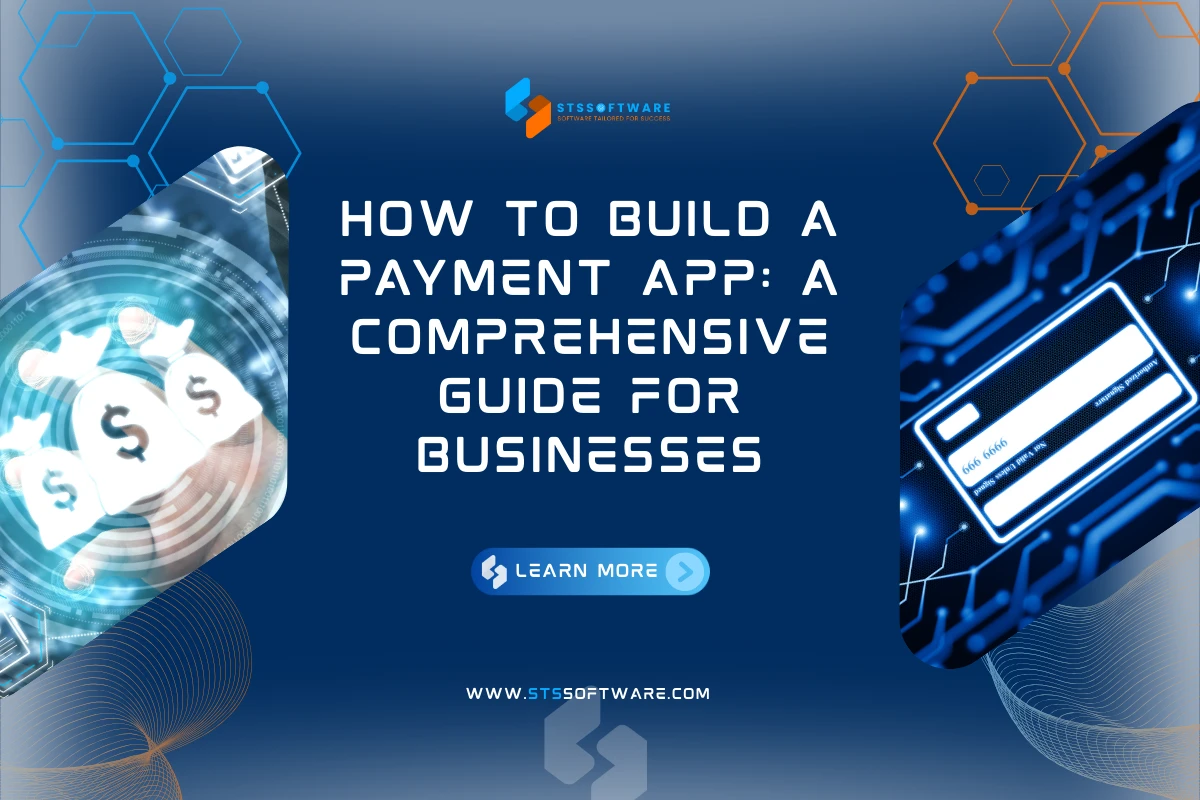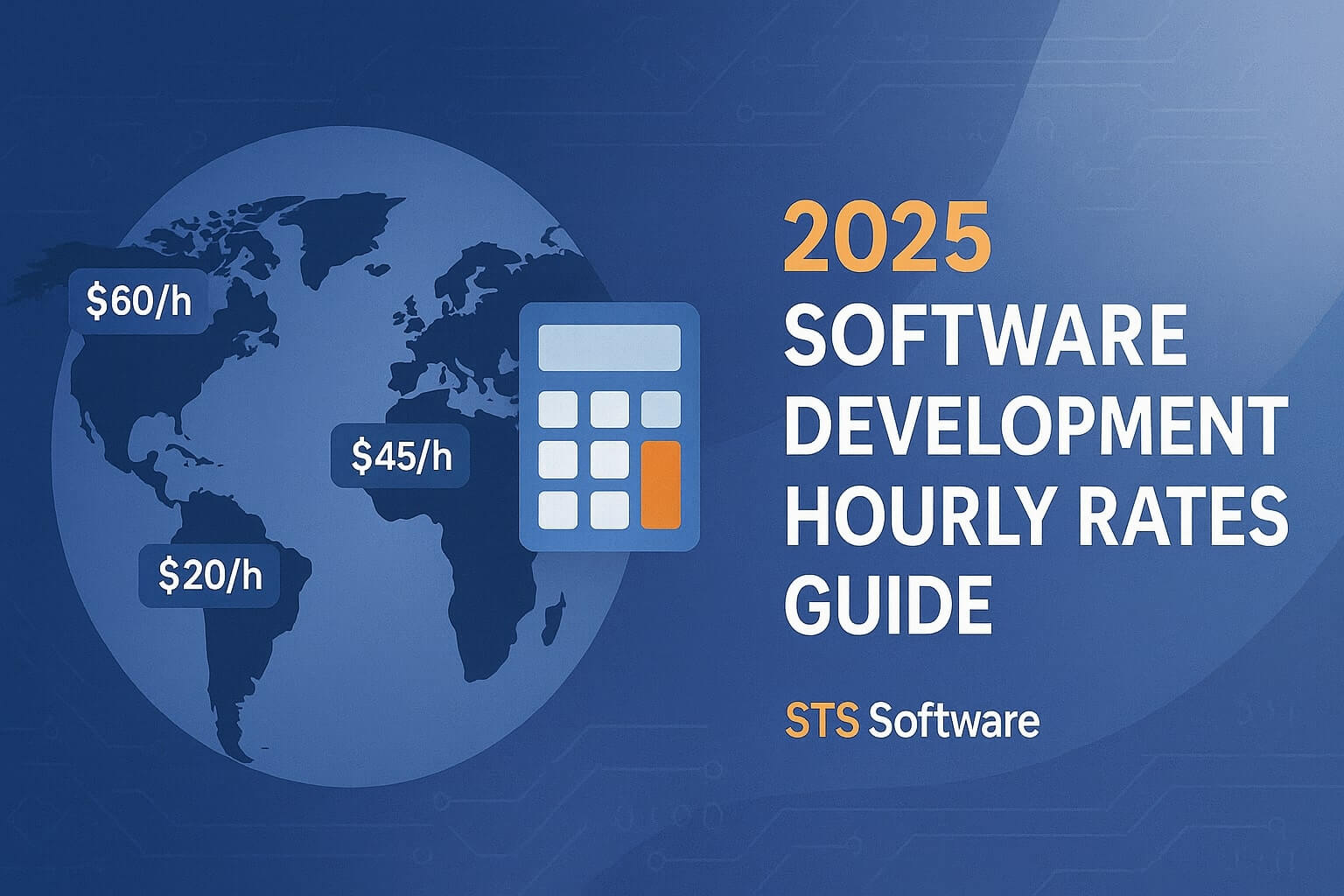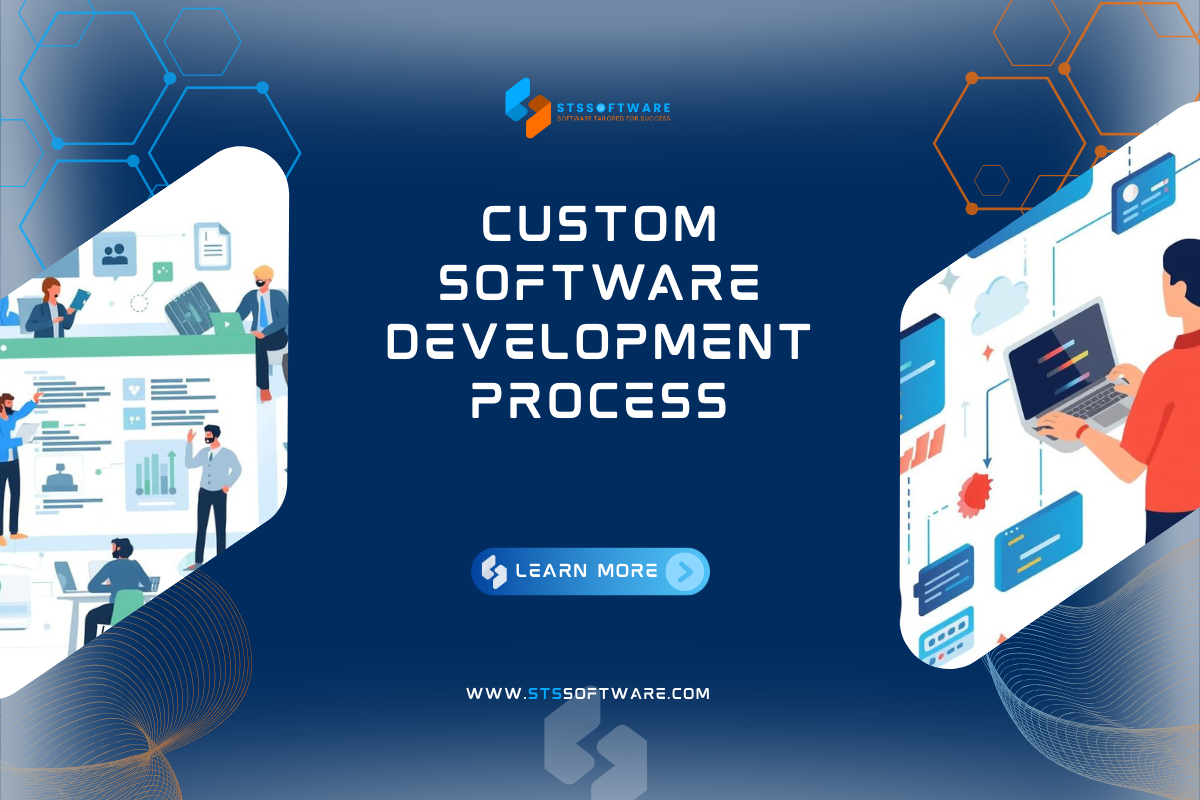The payment app market is red-hot. A 2024 McKinsey report shows 60% of US consumers use digital payments for in-app purchases, with proximity mobile payment transactions expected to surpass $1.2 trillion by 2028. Businesses, from startups to retailers, are racing to build apps to tap this growth. But how to create a payment app that stands out? You need smart planning, secure tech, and a slick design to compete.
STS Software knows how to build a payment processing app that wins. As a US-based fintech expert, we’ve created secure, user-friendly payment solutions for 13 years, helping businesses shine. This guide walks you through how to create a mobile payment app, from planning to launch, with practical tips for success. Ready to start?
Types of Payment Applications
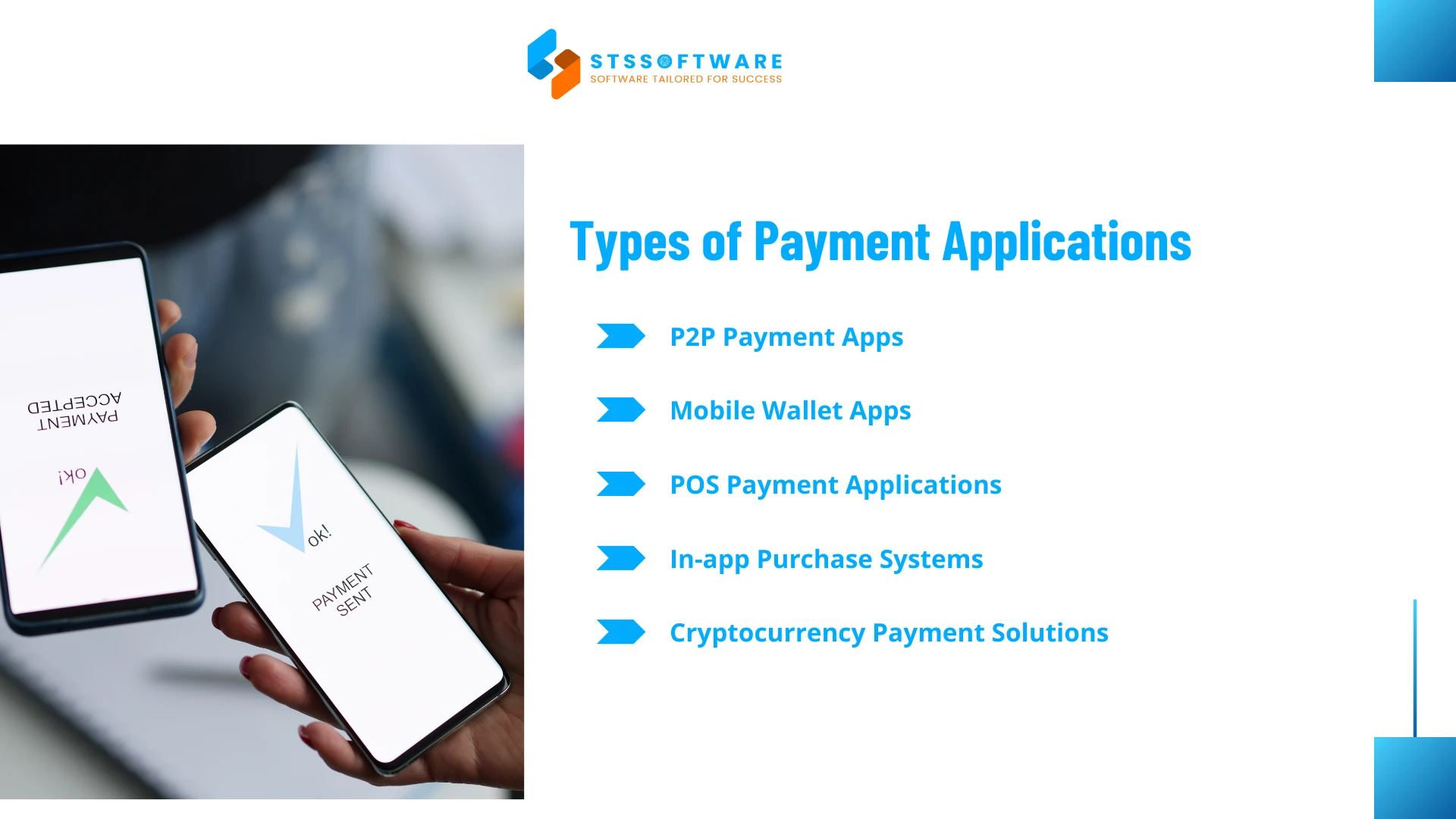
Mobile payment app offers a range of options, each tailored to specific user needs in the market. Knowing the types of payment apps is crucial to build a payment app for quick transfers or retail checkout. Here’s a breakdown of the main categories.
1. P2P Payment Apps
Peer-to-peer (P2P) apps allow splitting bills or sending cash. These apps enable instant money transfers, often free. They’re wildly popular, with 43% of Americans using P2P apps in 2021, per eMarketer, and usage growing steadily. Features like social feeds and bank integrations are key. To create a money transfer app, we prioritize speed and security, as users demand safe, real-time transfers.
2. Mobile Wallet Apps
Mobile wallet apps, like Apple Pay and Google Pay, store card details for contactless payments. These apps require NFC tech and robust encryption. In money transfer app development, mobile wallets excel for convenience, enabling payments at stores or online with a tap.
3. POS Payment Applications
Point-of-sale (POS) apps power merchant transactions. They’re essential for small businesses in places, handling cards or mobile payments. To build a payment app for POS, include hardware integration (e.g., card readers) and PCI DSS compliance. These apps boost sales with features like inventory tracking.
4. In-app Purchase Systems
In-app purchase systems, used by apps like Uber or DoorDash, allow seamless payments within an app. For mobile payment app development, smooth checkout and payment gateway integration are crucial to keep users engaged.
5. Cryptocurrency Payment Solutions
Crypto payment apps support Bitcoin or Ethereum transactions. To create a money transfer app for crypto, it is a must to ensure blockchain integration and regulatory compliance.
Key Features of a Successful Payment App Development
To build a payment app that users love, you need the right features to make transactions fast, secure, and easy. These must-have features make your app stand out.
1. User Authentication and Authorization
Users need to trust they’re the only ones accessing their money. To create a payment app, include user authentication like email/password login or biometrics (e.g., Face ID on Apple Pay). Authorization confirms users can only perform allowed actions, like sending money but not editing account details. Some apps use two-factor authentication (2FA) to verify identity, keeping accounts safe for users.
2. Payment Processing Capabilities
The heart of how to build a payment processing app is smooth transactions. Integrate payment gateways like Stripe or PayPal to handle card, bank, or wallet payments. We also maintain PCI DSS compliance for secure processing, which is vital for merchant apps in retail hubs.
3. Transaction History and Reporting
Users want to track their spending. Transaction history shows past payments with detailed logs. Reporting can offer insights like monthly spending summaries. Making history searchable and exportable helps small business owners manage finances.
4. Notifications and Alerts
Keep users in the loop with notifications. Push alerts for completed payments or low balances, like PayPal’s real-time updates, boost engagement. Alerts for suspicious activity enhance trust. In mobile payment app development, customizable notifications keep users stay informed without spam.
5. Account Management
Nowadays, business should let users control their profiles. Account management includes updating bank details, setting payment limits, or linking cards. Easy navigation is key to create a payment app that feels intuitive, especially for Gen Z users who value quick setup.
6. Security Features
Security is mandatory. Use encryption to protect data and tokenization to secure transactions. Regular audits and following strict data privacy regulations guarantee that user information is always protected. This helps businesses build lasting trust with their users and show a strong commitment to transparency and security.
7. Additional Features
Stand out with extra features designed for convenience and functionality like card management or recurring payments for subscriptions. Features like QR code scanning for simplifying checkouts or split payments for flexibility in group transactions, add convenience and make your app a go-to for users.
Pre-Development Planning
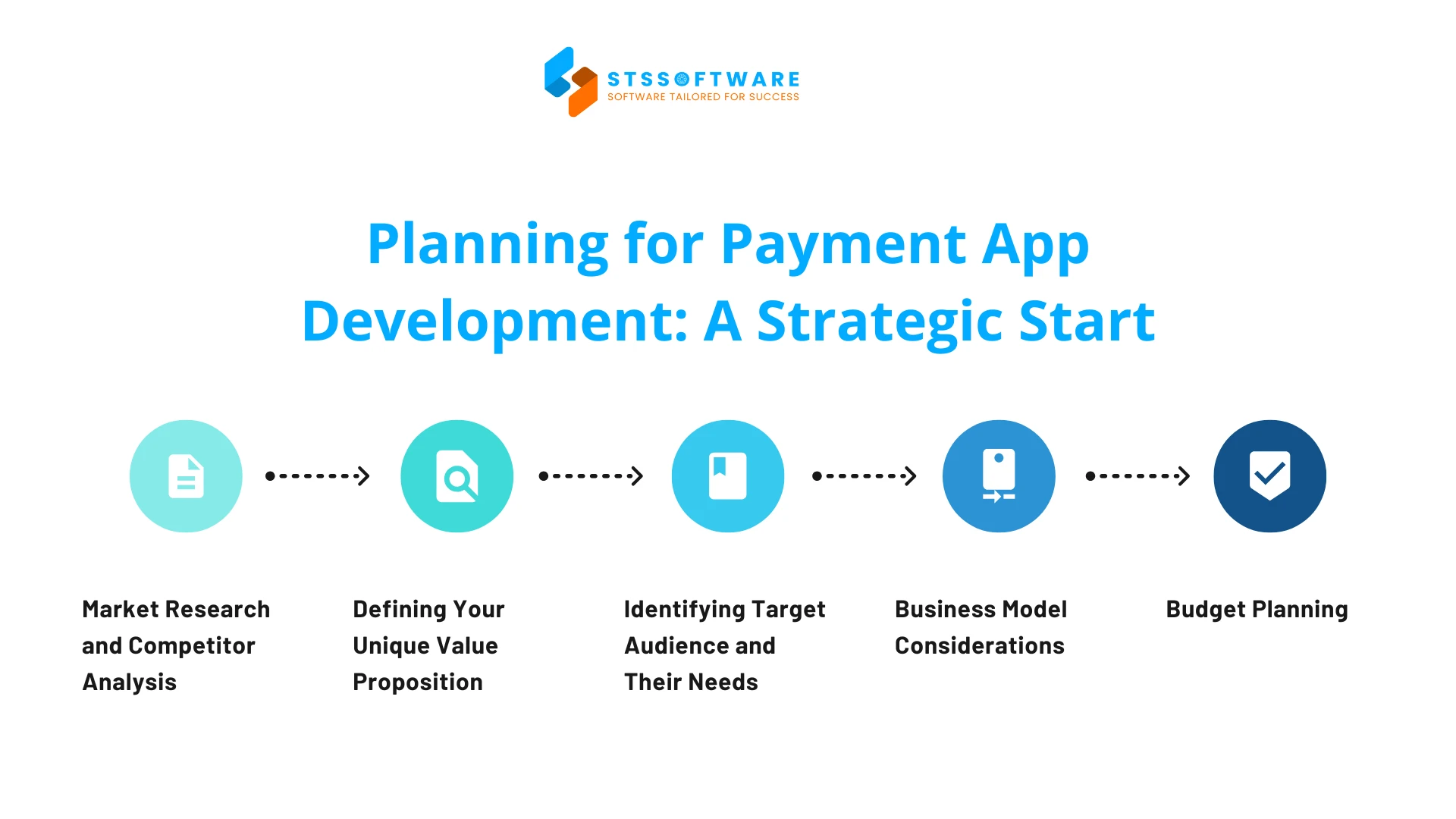
Before jumping into payment app development, careful planning makes your app hit the mark for users. To create a money transfer app that stands out, you need to research, carve out your niche, and budget smartly. Here’s how to set up for success in how to create a payment app with STS Software’s expertise leading the way.
1. Market Research and Competitor Analysis
Kick off with market research to understand the payment scene. Study competitors like Venmo and Zelle using tools like Sensor Tower to spot trends. Are users after faster transfers or lower fees? Find gaps, like crypto integration, to differentiate. This helps your app meet real demands.
2. Defining Your Unique Value Proposition
What makes your app unique? A clear unique value proposition (UVP) is key to how to make a money transfer app. Offer instant transfers with no fees, or merchant-focused QR payments. Consider what users crave, speed or rewards? A strong UVP increases downloads. STS Software creates UVPs that connect, positioning your app pops in the crowded fintech market.
3. Identifying Target Audience and Their Needs
Pinpoint your users, Gen Z splitting bills or retailers needing POS? Use surveys to uncover needs like speed or security. Tailor features like alerts or crypto options to fit. In the planning phase, STS Software aligns your app with audience expectations.
4. Business Model Considerations
How will your app earn cash? To build a payment app, choose a monetization model. Transaction fees, premium subscriptions, or merchant partnerships, work well. Balancing costs and user appeal is the way to maximize revenue while keeping users satisfied.
5. Budget Planning
Budgeting is critical for how to create an app. A simple app costs $50,000-$100,000, while complex ones reach $200,000+. Business has to allocate for research, design, development, and testing. You also need to plan for ongoing maintenance. Our payment app development services help you budget wisely for a top-notch app with a clear price quotation.
Technical Requirements and Development Approach
From choosing the right tech to streamlining development, every decision counts in payment app development. STS Software selects stacks that balance cost and performance for fintech needs.
Frontend Development
The frontend makes your app shine. iOS apps, built with Swift, offer smooth performance. Android apps, using Kotlin, cater to diverse devices. Web interfaces, often React-based, ensure browser access.
Backend Architecture
The backend powers transactions. Use Node.js for fast, scalable APIs, or Python for robust security. Microservices architecture ensures flexibility, handling spikes during Black Friday sales.
Database Design
SQL databases, like PostgreSQL, manage structured data, such as transaction records. NoSQL, like MongoDB, handles user profiles for flexibility. It is crucial to keep encryption and CCPA compliance to protect data.
API Integration Considerations
APIs connect your app to the world. Integrate banking APIs for account linking, payment gateways for transactions, and KYC APIs for identity checks.
Development Methodology
Agile and DevOps improve efficient development. Agile breaks projects into sprints, iterating features like notifications based on user feedback. DevOps automates testing and deployment for fast updates.
Payment Gateway Integration
To build a payment app, payment gateway integration is your make-or-break moment. This section explores how to build a payment processing app with smooth transactions, packed with practical tips and STS Software’s expertise.
1. Popular Payment Gateways and Processors
Picking the right gateway sets the foundation for payment app development. Here are top US-friendly options:
- Stripe: Powering apps with developer-friendly APIs, charging 2.9% + $0.30 per transaction. Ideal for startups needing flexibility.
- PayPal: Offering one-tap checkout and global reach. Fees start at 2.9% but drop for high volumes.
- Square: Perfect for small businesses, with in-person fees at 2.6% + $0.10.
- Authorize.Net: Suits enterprise apps with advanced fraud detection, charging 2.9% + $0.30.
Tip: Choose gateways with PCI DSS compliance and bank support. STS Software helps match gateways to your app’s needs, balancing fees and features for users.
2. Integration Options and Methods
How you integrate gateways shapes the user experience. Consider these methods:
2.1 Hosted Solutions: Users are redirected to the gateway’s page.
- Pros: Easy setup, low compliance burden
- Cons: Breaks app flow, less branded.
2.2 API Integrations: Embed payments in-app for a seamless feel.
- Pros: Customizable, keeps users engaged.
- Cons: Needs strong security.
2.3 SDKs: Speed up mobile integration.
- Pros: Fast, mobile-optimized.
- Cons: Limited customization.
3. Handling Multiple Payment Methods
A versatile app supports diverse payment methods to create a money transfer app that clicks. Offer these for users:
- Credit/Debit Cards: Used by 80% of US consumers.
- Bank Transfers (ACH): Low-cost, popular for P2P apps, with $0.25–$1 fee
- Digital Wallets: Apple Pay or Google Pay
- Cryptocurrency: Growing for tech-savvy users
Tip: Use gateways like Stripe to manage methods via one API. STS Software builds flexible systems, ensuring your app meets varied preferences.
4. Transaction Flow Implementation
A slick transaction flow keeps users coming back. Follow this process:
- Authenticate User: Use 2FA or biometrics (e.g., Face ID) to verify identity.
- Collect Payment Details: Securely gather card or wallet info via tokenized forms.
- Process Payment: Send data to the gateway with encryption.
- Handle Errors: Show friendly messages for declines, like “Card declined, try another.
- Confirm Transaction: Deliver instant receipts via push notifications or email.
5. Testing Payment Integrations
Testing is your safety net when building a reliable payment app. Before launch, it’s essential to carefully test every component to assure your app performs smoothly under real-world conditions.
- Sandbox Testing: Use Stripe’s test mode to simulate payments without real charges.
- Edge Cases: Test failed payments, refunds, or 1,000 simultaneous transactions, like PayPal during Black Friday.
- Compliance Checks: Verify PCI DSS and CCPA compliance with tools like Qualys.
- Real-World Scenarios: Mimic cross-border payments or mobile wallet taps in busy stores.
Security and Compliance in Payment App Development
Security and compliance are the foundation of any money transfer app that earns users’ trust. In a digital landscape where consumers are concerned about data privacy, even a single security lapse can severely damage your app’s credibility. Airtight security and regulatory compliance aren’t just best practices, they’re business critical.
1. Data Encryption and Protection Measures
Encrypting data is your first line of defense in payment app development. Use encryption to scramble sensitive info, like card numbers. Tokenization replaces data with unique tokens, minimizing breach risks, as seen in Apple Pay. Secure protocols for data transfers are a must, protecting transactions on public Wi-Fi in coffee shops.
Pros: Enhances user trust, meets regulatory standards.
Cons: Requires expertise to implement correctly.
Tip: Use libraries like OpenSSL for reliable encryption. Regularly update keys and monitor to catch vulnerabilities.
2. Fraud Prevention Mechanisms
Fraud is one of the biggest threats. If not addressed earlier, it can derail your entire development project. To protect your platform and your users, it’s essential to deploy these mechanisms.
- AI-Based Monitoring: Machine learning models analyze user patterns (e.g., transaction frequency, location) to flag anomalies, such as multiple transfers cross-border.
- Velocity Checks: Limits rapid transactions (e.g., 10 transfers in 5 minutes) to block account takeovers
- Fingerprinting Device: Track device IDs, IP addresses, and browser data to detect unauthorized access
- Multi-Factor Authentication (MFA): Require SMS codes, biometrics, or app-based tokens for high-value actions
Pros: Effectively reduces the risk of fraud and financial losses by identifying suspicious activity early.
Cons: If not carefully balanced, it may slow down the user experience or create friction during transactions.
3. PCI DSS Compliance
PCI DSS (Payment Card Industry Data Security Standard) compliance is non-negotiable for apps handling card payments. Non-compliance can lead to fines of $5,000–$100,000 per month and loss of card-processing rights. This standard, enforced by the PCI Security Standards Council such as:
- Build Secure Networks: Deploy firewalls and segment networks to protect cardholder data environments.
- Protect Data: Encrypt stored card data and restrict access to cryptographic keys.
- Vulnerability Management: Use antivirus software and patch systems promptly.
- Access Control: Assign unique IDs to staff and limit data access based on role.
- Monitoring and Testing: Log all system activity and scan for vulnerabilities.
- Policy Maintenance: Document security policies and train staff annually.
Pro: Builds credibility, avoids penalties.
Cons: Time-intensive audits.
4. KYC and AML Regulations
To operate legally in the US, your payment app must comply with Know Your Customer (KYC) and Anti-Money Laundering (AML) regulations. These safeguards protect your platform from fraud, identity theft, and financial crime.
KYC involves validating the identity of users before granting access to financial services. Common methods include:
- Document Verification: Scan government-issued IDs like passports or driver’s licenses.
- Biometric Authentication: Use facial recognition to match live selfies with ID photos, adding a layer of security.
- Address Verification: Confirm user addresses through utility bills or financial statements.
- AML Compliance: Monitoring for suspicious activity.
Mandated by the US Bank Secrecy Act, AML practices focus on identifying and reporting suspicious transactions. Key components include:
- Large Transactions: Transfers over $10,000 must be reported to FinCEN (Financial Crimes Enforcement Network).
- Transaction Patterns: Watch for activities like structured small transfers intended to avoid detection.
- Geographic Risk: Flag transactions involving high-risk jurisdictions.
STS Software designs and integrates fully compliant KYC/AML systems tailored to each country’s regulations. Whether you’re launching in Boston, Seattle, or anywhere in between, we promise your app meets legal standards while delivering a smooth user experience.
5. GDPR and Other Privacy Regulations
When building a mobile payment app, protecting user data is a legal and ethical obligation. With increasing regulations around the world, compliance is essential to earning user trust and avoiding costly penalties.
For apps with international users, the General Data Protection Regulation (GDPR) applies to anyone in the European Union. Key requirements include:
- User Consent: Users must explicitly opt-in before any data is collected. Consent records must be stored and traceable.
- Data Minimization: Collect only essential information for app functionality.
- Right to Erasure: Users must be able to delete their data on request.
- Breach Notification: If a data breach occurs, it must be reported to authorities within 72 hours.
- US Regulations: CCPA and Emerging Laws
In the US, the California Consumer Privacy Act (CCPA) is a leading example of state-level legislation. It applies to any app that serves users and includes requirements such as:
- Data Transparency: Clearly disclose what data is collected and how it is used.
- Opt-Out Options: Allow users to opt out of having their data sold.
- Policy Updates: Privacy policies must be reviewed and updated annually.
6. Security Testing and Auditing
In payment app development, testing and audits are essential to defending against evolving cyber threats.
- Penetration Testing: Simulate real-world attacks to uncover vulnerabilities before hackers do.
- Static Code Analysis: Scan your source code and catch security flaws early in the development cycle.
- Dynamic Testing: Run live tests to detect vulnerabilities in running applications, such as weak or exposed APIs.
- Compliance Audits: Schedule third-party audits every 6-12 months to ensure adherence to PCI DSS, CCPA, and GDPR.
- Stress Testing: Simulate heavy traffic, like 10,000 transactions/minute during peak times, to assess system performance under pressure.
- Vulnerability Scanning: Conduct automated weekly scans to detect and fix new threats.
You can implement quarterly penetration tests and weekly vulnerability scans. For example, PayPal conducts regular audits to keep top-tier security. STS Software applies the same high standards, giving you confidence that your app is protected from every angle.
UI/UX Design for Payment Application Development
UI/UX design is the soul of a mobile payment app. A seamless and trustworthy interface can transform your app into a daily essential. Let’s explore the art of building a user-friendly experience for mobile payment app, infused with practical insights from STS Software.
1. Design Principles for Financial Applications
A financial app’s design requires a delicate balance of clarity and reliability to create a payment app that feels like a trusted companion. Start with simplicity, using clean layouts to make sure that users can send money or check balances easily. A consistent look, such as uniform fonts, colors, and button styles, creates a familiar, polished feel.
Instant feedback, such as a subtle animation confirming a payment, reassures users their actions are successful. Next, you need to guide attention with visual hierarchy by making critical buttons like “Pay” stand out through size or color. Smart form design prevents errors before they happen. While it’s tricky to blend simplicity with robust features, prototyping and testing can perfect the balance.
2. User Flow Optimization
A well-crafted user flow turns transactions into smooth journeys in a mobile payment app. Think of a user flow as the path someone follows to complete a task, like sending money or reviewing past payments.
- Map Key Flows: Identify core actions (e.g., login, payment, confirmation) and sketch them.
- Minimize Steps: Reduce clicks from selecting a recipient to confirming. Ideally, a payment should take 3-4 steps.
- Clear Navigation: Use bottom navigation bars for mobile apps, placing frequent actions like “Send” or “History” within thumb reach.
- Progressive Disclosure: Show only necessary options at each step to avoid overwhelming users.
- Error Handling: Guide users through mistakes with clear prompts, like “Invalid card number, please re-enter.”
3. Accessibility Considerations
Accessibility ensures your app is usable by everyone, a must for mobile payment app development. Following WCAG 2.1 (Web Content Accessibility Guidelines) guidelines ensure your app works for people with disabilities.
- Color Contrast: Use ratios of at least 4.5:1 for text to aid visually impaired users.
- Screen Reader Support: Ensure compatibility with VoiceOver (iOS) and TalkBack (Android) for blind users.
- Text Size: Allow adjustable font sizes up to 200% without breaking layouts.
- Keyboard Navigation: Support tab-based navigation for motor-impaired users.
- Alt Text: Add descriptions for icons and images, like “Send Money button.”
4. Building Trust Through Design
Transparent design builds confidence. Design elements that foster trust include:
- Transparency: Display clear fees, transaction statuses, and security badges on payment screens.
- Professional Aesthetics: Use high-quality visuals and modern typography to signal reliability, avoiding outdated or cluttered designs.
- Secure Visuals: Show lock icons or “HTTPS” indicators during payments to reassure users.
- Consistent Branding: Align colors and logos with your brand to build recognition.
- User Control: Offer undo options or confirmation prompts, like “Are you sure?”, to prevent errors.
5. Mobile-First Approach
STS Software prioritizes the mobile-first approach, which is non-negotiable for mobile payment app development. Design for small screens first:
- Responsive Layouts: Use flexible grids in CSS or frameworks like Flutter to adapt to various screen sizes.
- Thumb-Friendly Design: Place key buttons in the thumb zone, typically the bottom center of the screen.
- Fast Load Times: Optimize images and code to load screens in under 2 seconds, critical for users on 4G.
- Touch Targets: Ensure buttons are at least 44×44 pixels for easy tapping, per Apple’s guidelines.
- Offline Support: Cache recent transactions for limited connectivity, enhancing usability.
Quality Assurance for Payment Apps
Quality assurance (QA) is the foundation of building a mobile payment app. They validate that your app not only works under normal conditions but performs flawlessly under high traffic and pressure.
1. Testing Strategies
Begin with a comprehensive plan that spans the development lifecycle, blending manual and automated approaches. The challenge is balancing speed with thoroughness, so you need a test case management tool to streamline planning.
Manual testing, ideal for exploratory checks, involves testers simulating user actions like sending payments or updating profiles. Automated testing accelerates repetitive tasks, such as verifying login across devices.
Prioritize unit testing to validate individual components like payment processing logic and integration testing to maintain modules like APIs and databases work harmoniously. Regression testing confirms new updates don’t break existing features, critical for frequent releases.
2. Security Testing
Security testing identifies vulnerabilities that could expose sensitive information, like card details or transaction histories. The challenge lies in staying ahead of evolving threats, but scheduling quarterly tests mitigates risks.
3. Performance Testing
Performance testing assures your app stays fast and reliable even when user demand peaks. By simulating real-world scenarios, this process evaluates how your app handles speed, scalability, and long-term use through techniques like load testing, stress testing, and endurance testing. The key challenge is accurately replicating diverse user environments and traffic patterns to uncover performance issues before they impact real users.
4. User Acceptance Testing
User acceptance testing (UAT) confirms your app meets user expectations. In this stage, the app is tested in a real-world-like environment to confirm its functionality, usability, and overall user experience. It’s essential to define clear test scenarios and collect direct feedback on issues like confusing interfaces, slow response times, or transaction failures. The main challenge is effectively managing diverse feedback and prioritizing fixes that impact user satisfaction.
5. Continuous Integration and Delivery
CI/CD is the engine behind smooth, consistent updates in mobile payment app development. Continuous Integration (CI) means developers frequently merge code changes into a shared repository to catch bugs early. Continuous Delivery (CD) builds on this by automating the release process, enabling rapid, error-free releases to users. With properly configured pipelines, each code update is tested for security, performance, and functionality.
Post-Launch Considerations in Payment App Development
Launching your app is just the beginning, earning long-term user loyalty requires consistent performance, security, and scalability. Here are the key strategies:
- Schedule weekly bug fixes and updates for iOS/Android compatibility and use automated alerts to flag transaction failures
- Measure daily users and transaction drop-offs, then aim for 2-second load times to meet expectations
- Collect input through in-app surveys and social media mentions
- Prioritize fixes for common issues like login errors and engage users with update notifications to foster loyalty
- Stay ahead of security risks and regular audits
- Prepare for high-demand periods
- Optimize databases and test scalability to handle millions of users
Cost and Timeline Estimation for Payment App Development
Understanding the cost and time required to build a mobile payment app is essential for proper planning and ROI evaluation. Several key factors shape the budget and development timeline, from technical complexity to team composition.
1. Factors Affecting Development Costs
The overall cost depends on the app’s features, security requirements, platform compatibility (iOS, Android, or both), and third-party integrations (such as payment gateways or KYC tools). Custom UI/UX design, compliance with industry regulations, and advanced technologies like AI fraud detection or blockchain can also increase the investment.
2. Typical Timeline for Payment App Development
A basic peer-to-peer (P2P) payment app may take 4-6 months to develop, while a full-featured merchant payment solution could require 8-12 months or more. This includes phases like discovery, UI/UX design, development, QA testing, and deployment. Timelines may extend based on scope changes or regulatory approvals.
3. Required Team Composition
A successful app build typically requires a cross-functional team including a project manager, business analyst, UI/UX designer, frontend and backend developers, QA engineers, and DevOps specialists. For fintech apps, cybersecurity experts and compliance consultants are also essential.
4. Ongoing Maintenance Costs
After launch, expect ongoing expenses for server hosting, API monitoring, regular updates, bug fixes, and security patching. Depending on the app’s scale, monthly maintenance costs can range from $5,000 to $20,000.
5. ROI Considerations
Return on investment depends on user acquisition, transaction volume, retention, and monetization strategies such as transaction fees, subscriptions, or partnerships. A well-executed app with strong backend infrastructure and intuitive UX can deliver substantial long-term gains.
Why Choose STS Software as Your Partner for Payment App Development
Building a financial app is a bold step, and with STS Software by your side, it becomes a smart, strategic success. As a US-based fintech leader, we combine deep technical expertise with a strong commitment to security, compliance, and user trust. STS Software is your ideal partner to build mobile payment apps.
1. Industry Expertise and Proven Success
STS Software has 13 years of hands-on experience in mobile app development, especially in developing budgeting, payment, and digital banking software. Our portfolio includes a wide range of fintech solutions, evidence of our ability to deliver high-performing, user-focused apps for both startups and enterprises.
2. Security-First Development Approach
We build secure apps from the ground up, following regulations and industry best practices. Our secure development lifecycle includes encryption and a secure development lifecycle. STS Software promises your financial app to meet the highest standards for data protection, which earn user trust and regulatory approval.
3. Comprehensive End-to-End Services
STS Software manages your entire app journey from concept and wireframing to app store deployment and post-launch optimization. We specialize in sleek UI/UX design, smooth API integrations, performance monitoring, and ongoing updates to keep your app competitive and engaging in the fintech space.
4. Regulatory Compliance Expertise
Whether you’re navigating CCPA, GDPR, or banking-specific regulations, our team is fully compliant across jurisdictions. We design with data privacy in mind, helping you build trust with users, banks, and regulators alike.
5. Long-Term Partnership and Growth Support
We don’t just launch your app, we help it grow. STS Software offers long-term support, from maintenance and AI-powered user analytics to scalable cloud architecture with AWS. With 24/7 support and forward-thinking solutions, we empower your app to evolve in a dynamic fintech landscape.
Conclusion
Building a payment app is a transformative journey in payment app development, unlocking new opportunities for businesses. This guide has walked you through the essentials of how to create a mobile payment app, from ideation to post-launch success.
Ready to build a money transfer app that shines? Connect with STS Software for a free consultation. Our expert team is here to help you transform your idea into a scalable, high-ROI solution for your business.



